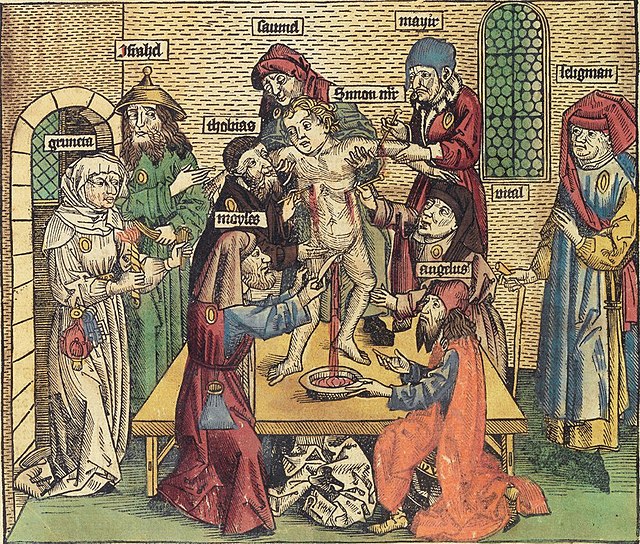Saint Robert of Bury was an English boy, allegedly murdered and found in the town of Bury St Edmunds, Suffolk in 1181. His death, which occurred at a time of rising antisemitism, was falsely blamed on local Jews. Though a hagiography of Robert was written, no copies are known, so the story of his life is now unknown beyond the few fragmentary references to it that survive. His cult continued until the English Reformation.
15th-century illumination depicting the martyrdom of St. Robert of Bury. Top left, a woman seems to be placing Robert's body in a well; top right, it is lying next to a tree with an archer standing by. The precise meaning of these scenes is unknown. At bottom, a monk prays to Robert's soul
Blood libel or ritual murder libel is an antisemitic canard which falsely accuses Jews of murdering Christians in order to use their blood in the performance of religious rituals. Echoing very old myths of secret cultic practices in many prehistoric societies, the claim, as it is leveled against Jews, was rarely attested to in antiquity. According to Tertullian, it originally emerged in late antiquity as an accusation made against members of the early Christian community of the Roman Empire. Once this accusation had been dismissed, it was revived a millennium later as a Christian slander against Jews in the medieval period. The first examples of medieval blood libel emerged in England in the mid 1100s before spreading into other parts of Europe, especially France and Germany. This libel, alongside those of well poisoning and host desecration, became a major theme of the persecution of Jews in Europe from that period down to modern times.

Statue of Simon of Trent, an Italian child whose disappearance and death was blamed on the leaders of the city's Jewish community
The crucifixion of William of Norwich depicted on a rood screen in Holy Trinity church, Loddon, Norfolk
Simon of Trent blood libel. Illustration in Hartmann Schedel's Weltchronik, 1493
Painting of Werner of Oberwesel as a martyr





